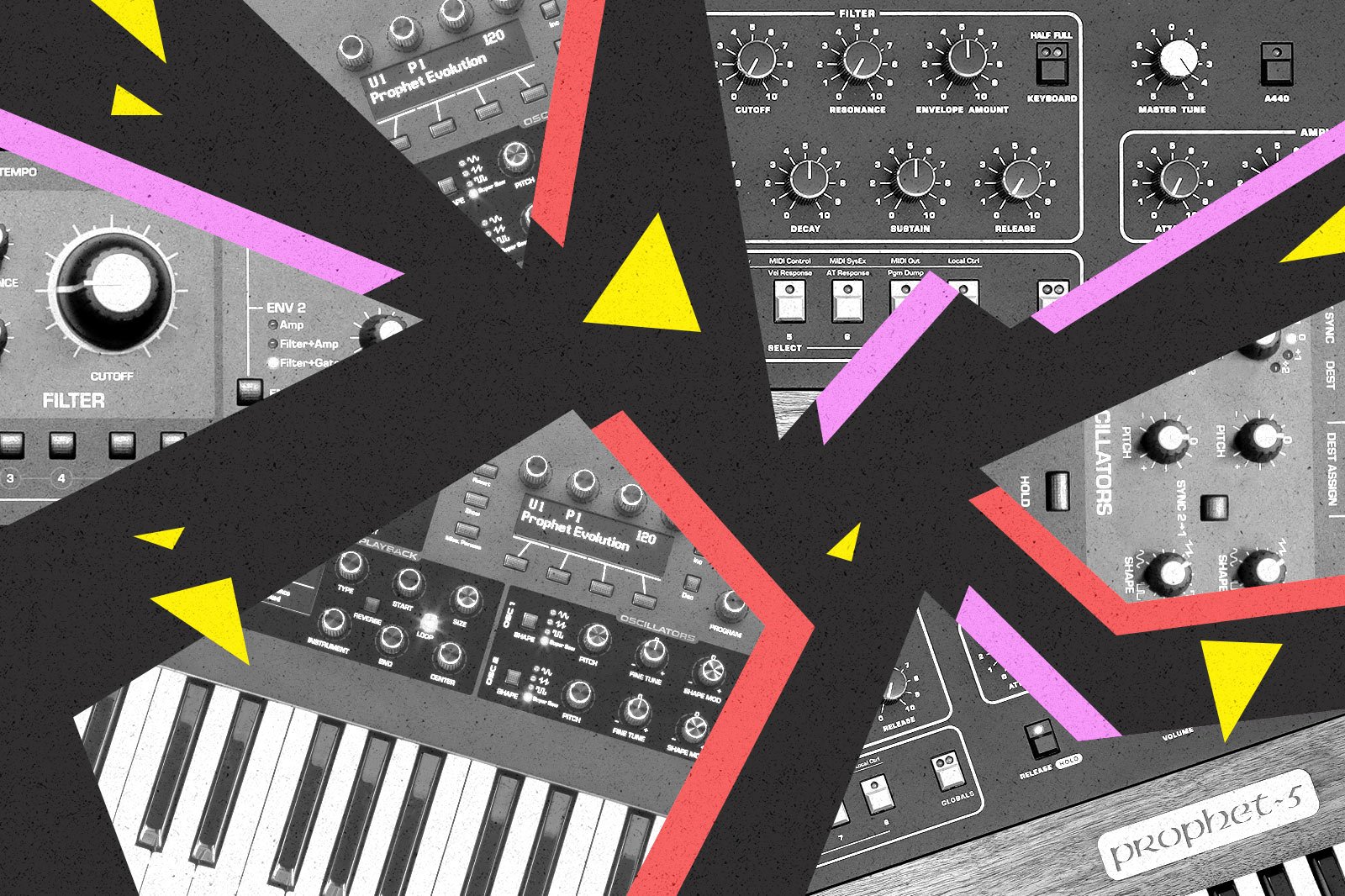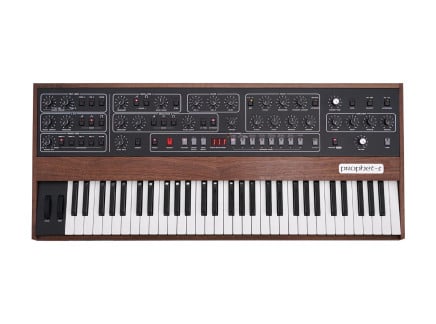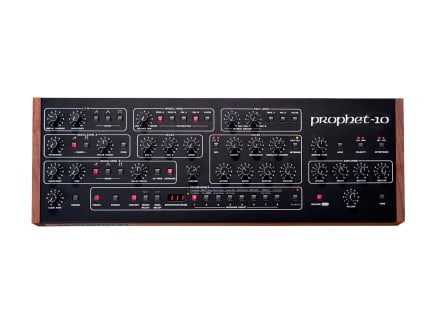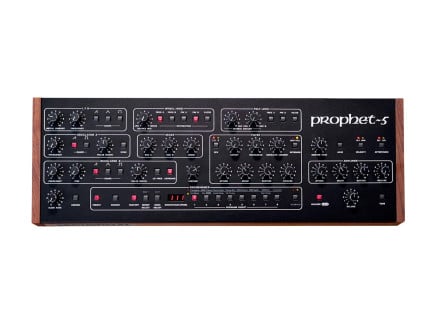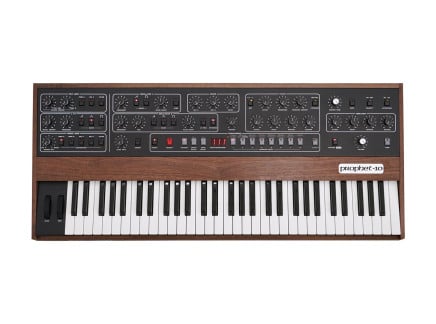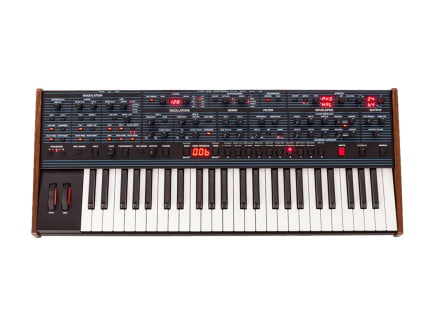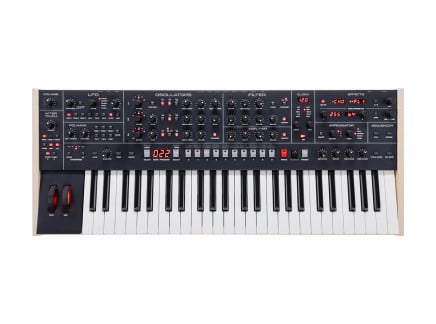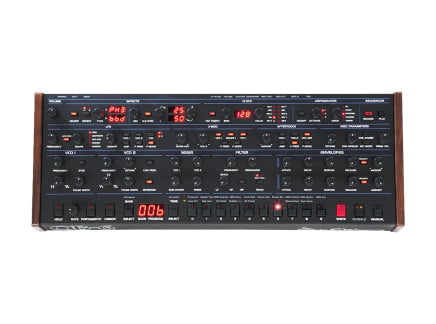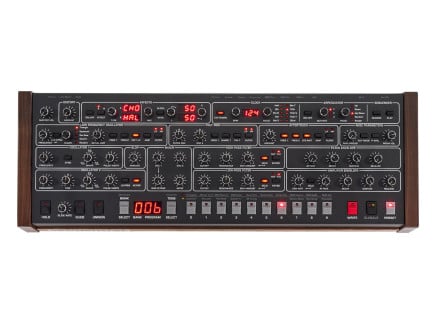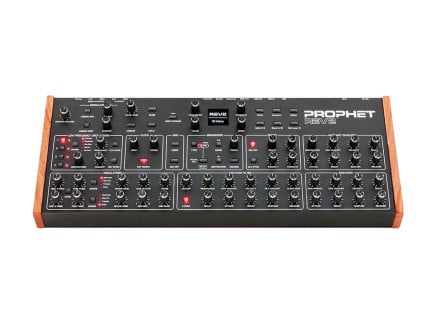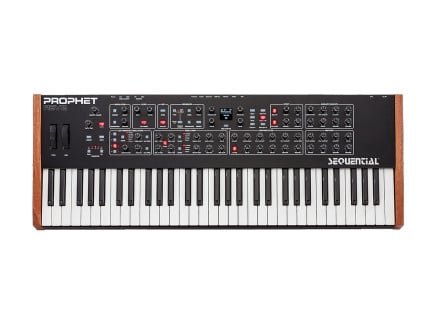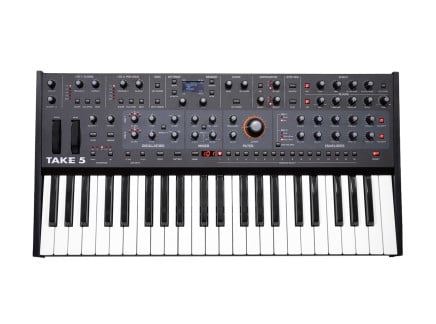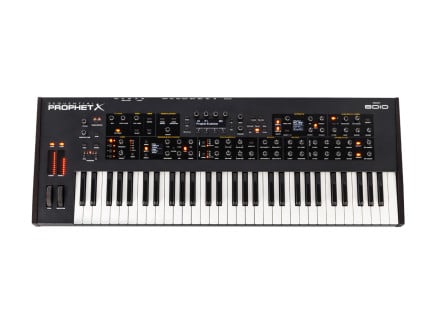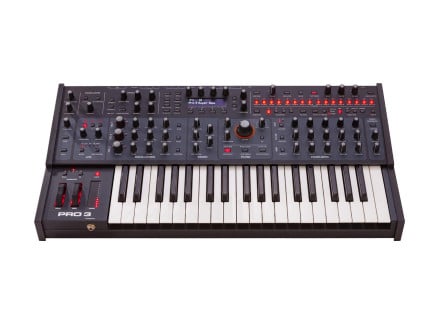When discussing synthesizers, it's inevitable that a few names come up—Bob Moog, Don Buchla, Tom Oberheim, Alan R. Pearlman, and of course...the late Dave Smith. Especially once we turn our focus specifically to polyphonic keyboard-based synthesizers, Smith's influence is inescapable: he was co-creator of the MIDI protocol, and a pioneer of the use of microprocessors in synthesizer design. Using his technical ingenuity, he founded an immensely successful instrument company, and created an instrument that shaped the form of most synthesizers that followed.
Of course, we're talking about Sequential Circuits, and we're talking about the Prophet-5—a synthesizer whose DNA can be found in nearly every commercial synthesizer that has followed it. Since the original Prophet, Smith and associates have created an enormous wealth of unique instruments, each with its own strengths and unique ways of approaching sound design and performance. The common thread among them? They all sound amazing, and have offered a tremendous amount of inspiration for the past four+ decades.
Today, Sequential continues Smith's work of creating tremendously powerful, inspiring electronic musical instruments. Their strong suit is the creation of polyphonic analog keyboard synthesizers, as well as hybrid instruments that make use of the powerful sound of analog with the flexible control and sound design potential of digital audio implementations. However, given that so many of the instruments share common features, it can be a bit difficult to parse the differences between all of their current offerings.
In this article, we're taking a look at every member of the current Sequential lineup, from the potent Take 5 to the classic Prophet-5 to modern classics like the Prophet-6 and hybrid Prophet X. If you've ever looked at Sequential's lineup and wondered what the difference is between each model of Prophet, or simply wondered which Sequential synth makes the most sense for you—buckle up. You're about to have your answers.
The Synth that Started it All: The Sequential Prophet-5
Of course, the most conspicuous member of the Prophet family is the one that started it all: the Prophet-5. Originally released c. 1978, the Prophet-5 was one of the first polyphonic keyboard synths available, using cutting-edge microprocessors to handle polyphonic voice addressing, and to store/recall settings for all of its parameters. When we think about modern standards for how an analog keyboard synthesizer should work, we often think of standards that began with the Prophet-5, and in many ways, it's still the archetypal model of what a polyphonic analog keyboard synthesizer should be.
In 2020, Sequential put the Prophet-5 back into production, bringing many musicians something they'd sought for years: a P-5 with modern connectivity, robust build, and the exact same sound/user experience as the original...with a few extra tricks up its sleeve. As such, the Prophet-5 Rev 4 has become one of the most prized electronic instruments currently in production. But what makes this now-over-40-year-old synth design so special and relevant to current musicians? Let's take a look at what the Prophet-5 Rev 4 contains.
The Prophet-5 Rev 4 maintains the same analog voice architecture as the original—in fact, aside from some quality-of-life improvements and additional expressive features, it's exactly the same as the vintage P-5. It offers five voices of polyphony, each with two Curtis 3340 oscillators, a noise source, a rich-sounding lowpass filter, and and amplifier. Moreover, each voice offers dedicated amp and filter ADSR envelopes. The first oscillator offers saw or pulse shapes (or both), along with the option for continuously variable pulse width and PWM. Oscillator B offers an independent frequency control with fine tone and a stepped coarse tuning pot, making it easy to dial in stacked oscillator sounds. Oscillator B offers saw, triangle, and pulse shapes (again, with the option for PWM); it can also be decoupled from the keyboard and/or set to low frequency range, great for everything from continuous audio drones to LFO behavior. Oscillator A can also be hard synced to Oscillator B for gnarly, metallic sync sweeps and more.
The filter offers two options: the 2140 filter and CEM3320 filter, making it possible to access the iconic sounds of each previous generation of Prophet-5. Each offers resonance into self-oscillation, and can be made to track the keyboard...meaning that in a pinch, they can act as a sine-like oscillator, themselves.
Modulation and expression in the Prophet-5 is straightforward; given the time of its development and its relatively simple voice structure, it does not contain a "modulation matrix." Instead it features two modulation busses on the left side of the panel: Poly-Mod and Wheel-Mod, alongside the LFO panel controls. The LFO offers an amplitude and rate control, and selection of any combination of saw, triangle, and square shapes. It can be assigned to any combination of Oscillator A and/or B's frequency and/or pulse width, or to the filter's cutoff via the Wheel-Mod section's Source Mix...which also allows you to blend in noise as a modulation source, great for creating grainer, chaotic modulation. Unlike the LFO section, the Poly-Mod section allows you to direct per-voice modulation to different parameters (namely Freq A, PW A, and the Filter). The source for Poly Mod comes from the filter envelope and/or the second audio oscillator, each with dedicated level controls. (Hint: this is a place where setting the second oscillator to "Lo Freq" range can be quite useful, though the P-5 sounds excellent with audio-rate modulation, as well).
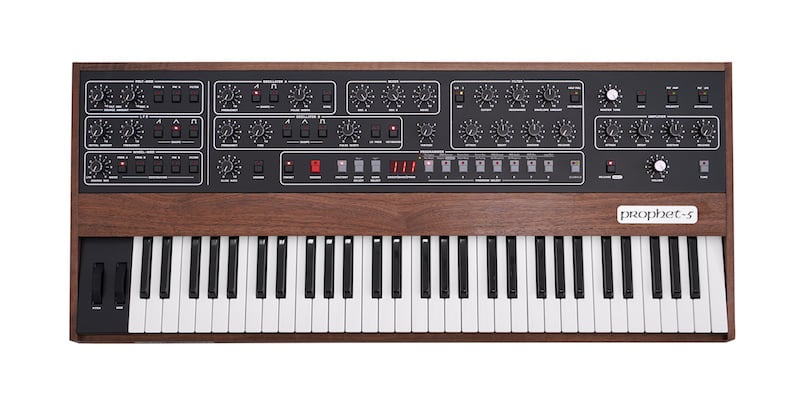
The Rev 4 imbues the 61-key keyboard itself with additional functionality—adding both velocity responsiveness and monophonic aftertouch. Velocity can be directed to the filter and/or amplifier, and aftertouch can be directed toward the filter or to the LFO's rate. Both the keyboard and desktop models respond to velocity and aftertouch via incoming MIDI, as well. The Rev 4 also includes Sequential's "Vintage" knob, which has now made it into a number of other products. This imparts variation to various aspects of each voice, making their tuning, filter response, and envelope response slightly different from voice to voice in order to emulate the sound of an older, somewhat out-of-shape machine for extra vintage-style charm.
The Prophet-5 Rev 4 is available in both keyboard and desktop format; and of course, the Prophet-10 Rev 4 is identical, with double the polyphony and bi-timbral capability, with the options for both splits and layers for the second timbre(!). Similarly, the Prophet-10 is available in both keyboard and desktop form factors. With space for 200 factory presets and 200 user presets, the sound of every version of the original, and greater opportunity for expressivity than ever before, the Prophet-5 isn't just an authentic recreation of the original—it's the most flexible Prophet-5 yet. So if you need the sound, playability, and workflow of the synth that started it all, look no further.
A New Take on a Classic: The Sequential Prophet-6
While the current Prophet-5 is a direct nod to Sequential's heritage, Dave Smith and his team took another approach to honoring this legacy back in 2015. Under his new company Dave Smith Instruments, they had produced a number of digital and hybrid instruments up to that point, and it finally it felt appropriate to return to where things all started: tricked out, analog polysynths. And the Prophet-6, as it would soon come to be known, certainly packs in all kinds of analog tricks, but embraces advancements in digital technology to create a well-rounded and complete polysynth package.
As an interesting aside, Prophet-6 development also coincided with Yamaha's generous return of the Sequential brand name to Dave Smith, after they had acquired the original company in the 1980s. Though Dave Smith Instruments wouldn't make the full name swap back to Sequential for a few more years, the Prophet-6 was still the first instrument to bear the iconic emblem in nearly 30 years. With all of the above considered, as well as its six-voice polyphony, it only makes sense that this new instrument would be named sequentially (pun intended) after its namesake and inspiration, as the Prophet-6 represents a true continuation of Smith's polysynth design philosophies.
Like the Prophet-5 before it, the Prophet-6 boasts true analog circuitry where it counts: VCOs, filters, and VCAs working together to deliver the lush timbres necessary for pads, basses, and leads. In particular, the VCOs are made with more modern and refined discrete circuitry, thus having a character that slightly differs from the original but still decidedly sounding like a Prophet. The four-pole low pass filter is also inspired by the Prophet-5, but an additional independent two-pole high pass filter opens up numerous new sound design opportunities, achieving everything from carving the rumble out of pads to nasally band pass sounds when both filters are used together.
But where the original included digital elements purely for the sake of managing preset memory, the Prophet-6 massively extends its digital side by offering digital stereo effects, polyphonic step sequencing, arpeggiators, and more. With the exception of the analog distortion, the dual-effects engine operates at 24-bit, 48kHz sample-rate—ensuring high-quality sound and effects processing in the studio, on stage, and anywhere else that you'd need to bring your Prophet-6. Though if you'd prefer to use some prized pedals or outboard gear in the studio, the internal effects may be fully bypassed, ignoring any digital conversion stages and maintaining the analog signal path all the way through. MIDI I/O is a given on a modern synth like this, but as a bonus, the latest OS firmware for the Prophet-6 enables MPE support—allowing for new expressive possibilities on a per-voice basis that wasn't possible before.
Given all that it has to offer, we think that the Prophet-6 is the perfect choice for anyone seeking the classic Sequential sound in a complete, modern package. It sounds nearly identical to the Prophet-5 in most contexts, and its inclusion of additional features on both the analog and digital sides pushes into new sonic territories that other Prophets can't achieve on their own.
The Prophet-6 did a remarkable job of modernizing the Prophet sound, and truly set the standard for what a well-designed analog polysynth should offer in the 21st century. In fact, it did this so well that even Sequential revisited the same form-factor for not just one but two later additions to their product catalog: the OB-6 and the Trigon-6.
Dave Smith + Tome Oberheim: The Sequential OB-6
Not long after the release of the Prophet-6, Dave Smith partnered up with Tom Oberheim to release the OB-6, this time paying homage to the legendary Oberheim sound. Both instruments share identical sequencing and effects engines, but sonically speaking, the OB-6 is truly an Oberheim in Prophet's clothing. Its lineage draws from the SEM VCOs and filters that gave the original 4- and 8-voice synths their iconic sound, but treated to modern updates and consolidated into a slick package.
The OB-6 features two oscillators within each of its six voices, and like the Prophet-6 these are true discrete VCO designs. Even just listening to the raw waveforms, the Oberheim sound is immediately apparent. But, of course, it's also the 2-pole SEM filter that makes the sound of the OB-6 so desirable. Unlike the separate lowpass and highpass filters found on the Prophet-6, the OB-6 features one state-variable filter with a continuous response sweep from lowpass through notch and on to highpass, with an optional bandpass mode. Notch filters are uncommon on polysynths, and, speaking as someone who is a big fan of this filter type, they can go quite a long way in coaxing unique sounds out of your instrument.
The Prophet-6 and OB-6 are frequently compared to each other, and out of all the instruments in the Sequential catalog, we're most often helping customers decide between these two. Ultimately, their functionality and sound should be the deciding factor—to our ears the Prophet-6 has a rounder, slightly mellower timbre to it that blends into a mix really well, whereas the OB-6 is a bold, cutting synth that demands to be heard. This is, without a doubt, attributed to the distinct design differences between the oscillators and filters found in both synthesizers. Neither is necessarily better than the other one, because they're both just two really good flavors of analog polysynth goodness.
Beyond the core sonic DNA differing so greatly from the Prophet-6 and the inclusion of other Oberheim features like X-Mod, the OB-6 does have quite a lot in common with its counterpart. The stereo dual effects engine remains in place, and it's worth mentioning that certain algorithms like Phaser 3 and Ring Modulator are emulations of classic Oberheim effects processors. And while the effects are identical between the two synths (and sound great on both), it's certainly nice to be able to pair an Oberheim synth with Oberheim effects.
Add in the arepggiator, polyphonic sequencer, and MPE support all wrapped up in wooden side panels with a 49-note premium Fatar keybed, and the OB-6 is well-rounded, modern representation of the classic, bold Oberheim sound. If you're in need of a nice polysynth to be the centerpiece of your music, it's hard to go wrong with the OB-6. Also, while not a Sequential product, Dave Smith played a big part in reviving the Oberheim brand with the release of the OB-X8, which is sonically and aesthetically as authentic of an Oberheim experience as you can get these days.
East Coast Polysynth: Sequential Trigon-6
Released towards the end of 2022, Trigon-6 was an unexpected surprise from Sequential—and with it are some of the most unexpected sounds to be heard from one of their instruments. Trigon-6 has the distinction of being the final instrument that Dave Smith worked on before his passing, and packs in a pleasant blend of old and new circuits and sounds inside. Like the OB-6, Trigon-6 incorporates many of the same effects and sequencing workflows as the Prophet-6, so we'll largely be focusing on the sonic differences in this section.
Like the OB-6, the Trigon-6 isn't really drawing from Sequential's own legacy with the Prophet sound, but there is another famous synth sound that Smith and his team were putting their own spin on. In fact, astute synthesizer fans might look at Trigon-6 and notice some very Moog-like features about it—and they'd be totally right. With three oscillators and a rich resonant lowpass filter inside, you could think of the Trigon-6 as a tricked-out polyphonic Minimoog or a long-lost descendent of the Memorymoog, but with the same ease-of-use and quality-of-life features that Sequential has been building into their current line of instruments for nearly a decade.
Once again, Trigon-6 features six discrete analog VCOs, built from the ground up for a different sonic flavor from the Prophets and OB-6. In line with the instruments that inspired it, there are three oscillators per voice, with octave switches and tuning controls to dial in subs and rich detune as desired. You can even do the classic Moog trick of setting oscillator three into LO mode with bypassed keyboard pitch tracking, giving you a bonus LFO for each voice.
The other big component of the Trigon-6 sound is its filter, which is actually derived from the ladder filter found in the Pro 3—and we speculate that this was a catalyst for Trigon-6 development. Together, the oscillators and lowpass ladder filter are capable of that beloved punchy sound that put Moog (and synthesizers, period) on the map all those years ago, and can do it in a wonderful polyphonic context that doesn't become too overbearing and thick. But if over-the-top is just the thing you want, hit the Unison button and bask in the glory of 18 oscillators stacked into a thick lead or bass.
Trigon-6 has its roots in the most classic of synthesizer sounds, but that's not all that it can do. For the more adventurous folks out there, Trigon-6 seemingly embraces the potential for unstable and chaotic feedback routings. The bipolar Feedback<>Drive knob pushes towards thick CP3-style drive when turned to the right, but the left side will begin to route each voice's output back into its filter for rumbly, gurgly grit. Oscillator 3, due to its flexibility in both the audio and control frequency ranges, is also available as a modulation source in the Polymod routing section. But crucially, it is also available as a destination, and the ability to route this to other places in the Trigon-6, while layered with the filter envelope, makes it one of the most adventurous sound design platforms that Sequential has ever released.
We're comfortable saying that the Trigon-6 is a neat take on one of the most quintessential synthesizer sounds of all time, while also managing to bring some new tricks to the table. If you've ever thought about how fun it would be to play a Minimoog polyphonically, Trigon-6 certainly delivers on that front. But it's also an instrument that embraces the bizarre sounds that synthesizers can make, and if you're willing to tag along for the ride, Trigon-6 could take you to some interesting and unexpected places.
An Alternate Take: the Sequential Prophet Rev2
Having read this far into our article, it should be clear that Sequential has a long-standing track record of iterating upon their designs, and improving things when the time is right. After all, the legendary Prophet-5 has gone through four revisions itself! But in the case of the Prophet Rev2, based on the Prophet '08 which fittingly came out in 2008, the changes were so significant that, in many ways, it feels like an all-new instrument.
Among the most notable of its features, the Rev2 is available with either eight or 16 voices of polyphony! Of course, 16 voices might initially seem like a bit of overkill, given that humans only have ten fingers, but these extra voices can be appreciated with the Rev2's split and bitimbral modes, which allow for two patches to be played at the same time. Use this to craft the most luscious pads imaginable, or split between punchy bass in the left hand and smooth lead in the right. Rev2 also sports a highly flexible modulation matrix—one of the most flexible available on an analog synthesizer, with eight slots, 22 sources, and 52 destinations on top of pre-defined routings available on the panel.
The Rev2 is, by definition, an analog polysynth, though it uses DCOs—digitally-controlled oscillators—at its core rather than standard voltage-controlled oscillators. This is the same oscillator approach as was used on classic synths like the Roland Juno-106, and DCO designs provide a couple of key benefits: they're generally more stable than VCOs, and are often cheaper to make as well. This is why even the 16-voice Rev2 sits at around $1000 less than the VCO-laden Prophet-5 and Prophet-6. DCOs can also open the door to interesting PWM-like waveshaping opportunities on all waveforms, which the Rev2 embraces in earnest.
Of course, there are also analog filters on the Rev2, utilizing Curtis chips that provide the same, smooth filter sound that was heard on the Prophet '08 and numerous instruments from the original era of analog synthesizers. This particular design is lowpass-only, but offers switchable operation between two or four-pole slopes—dial in either a gradual roll-off of high frequencies or a steeper and punchier slope that's perfect for basses and chord stabs.
Like several of Sequential's other instruments, Rev2 offers a digital effects processing engine to further enhance your patches. Reverbs, delays, chorus, distortion, phase shifting, and ring modulation offer more ways to push your sounds into richer places, all without the need for pedals or any other external gear! Best of all, a different effect may be assigned to each layer in split and bitimbral modes, so there's no need to worry about a bass patch muddying up the reverb or delay on your lead.
The Rev2 fits into an interesting place in the Sequential lineup—though it shares common DNA with all of the others, it has its own unique features to help it stand out. If you need the power of two synths in one package, or crave an analog powerhouse with unmatched modulation options, Rev2 just might be the synthesizer for you.
Portable, Yet Powerful: The Sequential Take 5
It may not say "Prophet" on its badge, but in discussing Sequential's current Prophet lineup, it's impossible to ignore the existence of the Take 5. Bringing the sound of the Prophet series to its smallest and most affordable form factor to date, the Take 5 is Sequential's offering to synthesists on a budget—or to synthesists who need a compact way to get great sounds in their studio or on the road.
Like the Prophet-5, Take 5 boasts five voices of polyphony, complete with true analog VCOs and VCFs—no DCOs here! It features a 44-note keybed (just under 26 inches long, all told), making it quite portable. While it might seem like a 44-note keybed isn't quite enough for some wider-spread synth lines, the keyboard itself can be divided into two performance zones, making it possible to transpose the bottom zone of keys down, for instance, giving you access to a wider range at hand's reach.
The Take 5's voice architecture includes two analog VCOs, a sub oscillator, noise source, and a resonant 4-pole analog lowpass VCF for each voice, great for creating thick, smooth, warm, and punchy tones. The oscillators each offer an octave switch, continuous pitch control, and continuously variable waveshape, allowing you to smoothly transition between sine, saw, square, and pulse shapes. The oscillators can be hard synced to one another, and the second oscillator can be used to frequency modulate the first. Oscillator 1 features a suboscillator (with dedicated level control in the pre-filter mixer), and you have access to both white and pink noise. The filter, complete with large front-panel cutoff knob, offers continuously variable resonance and drive, great for dialing in loads of character from smooth to aggressive.
Each of the two DADSR (ADSR + Delay) envelope can be routed to multiple destinations, and has the option to be velocity-responsive for expressive playing. Moreover, the Take 5 features two LFOs: one global, and one per-voice, each of which offers triangle, saw, ramp, square, and S&H stepped random shapes. Aside from front-panel assignments for the envelopes, it's also possible to create more complex modulation scenarios using the 16-slot modulation matrix, in which nearly every source and nearly every possible destination are available to be modulated—you could use noise to modulate the amount of FM, Osc2 to modulate Osc1's shape, a random source to modulate the filter's resonance, the list goes on! In fact, you can even use a modulation slot to alter the "amount" of modulation applied in a different slot...making it possible to, for instance, use key pressure to dial in the amount of randomness applied to the filter, to use key velocity to determine how strongly an envelope affects FM depth, and so on. It's pretty exciting, and leads to a lot of musical possibilities not present on its older sibling, the Prophet-5.
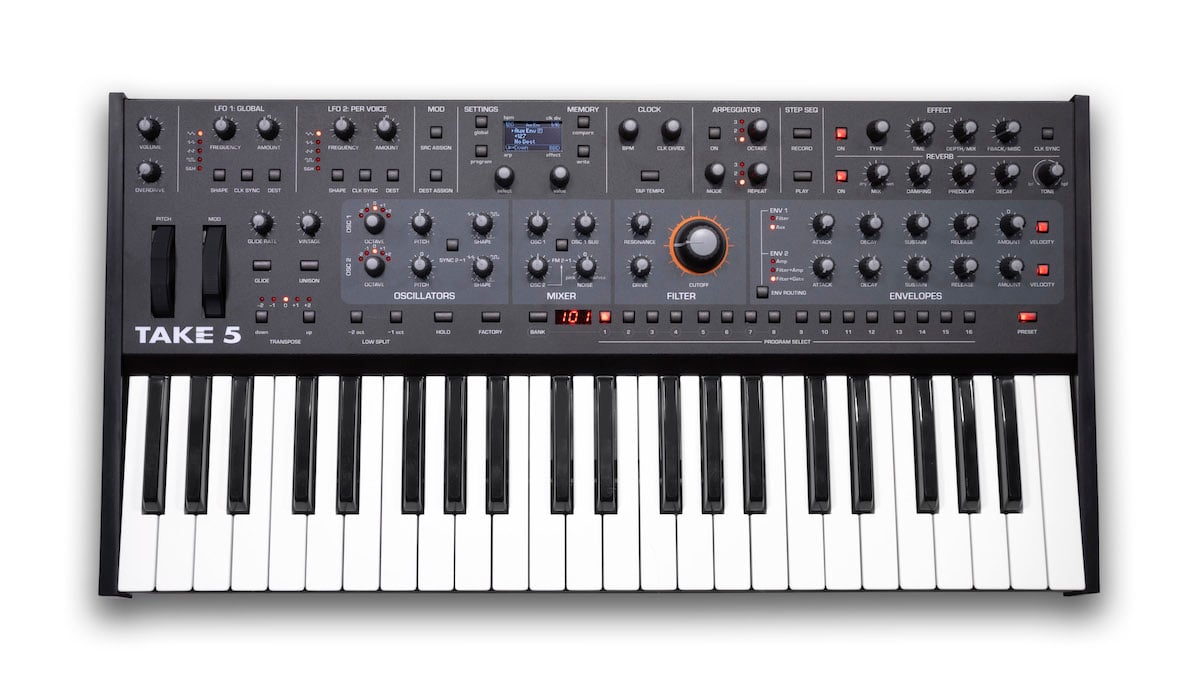
Of course, that's not the only "extra" trick Take 5 has up its sleeve. Take 5 also features a robust stereo effect section, with one global multi-mode digital effect processor and one dedicated reverb at the end of the signal chain. The multi-mode effect processor offers digital delay, BBD-inspired analog delay emulation, two flavors of tape-style delay, chorus, flanger, phaser, a highpass filter, distortion, ring modulation, and a rotating speaker effect—each of which have three variable parameters. The reverb is a plate-style effect, with variable time, tone, and early reflection controls. There's also a global overdrive available for adding crunch and saturation to your entire sound.
Additionally, Take 5 offers a fully-featured arpeggiator, an up to 64-step step sequencer, a velocity and aftertouch-capable keybed, and loads of extra options in its global menu. It has space for 128 factory programs and 128 user programs, meaning that you'll be able to keep designing your own sounds and interactions for a good while. All in all, the Take 5 is a quite compelling synth—one that offers the sequential sound at a great price and a compact form factor, without sacrificing flexibility in terms of modulation and performance capability. If you need a small, great-sounding, flexible analog synth for your touring rig or your compact studio, Take 5 is an excellent choice.
The Prophet Reimagined: The Sequential Prophet X
The Prophet X is a new take on the Prophet concept altogether, borrowing inspiration from a number of its predecessors and pushing the product line into entirely new territory. In short, Prophet X is a bi-timbral hybrid synthesizer with digital oscillators, a 16-bit, 48kHz sample playback engine, and 150GB of high-quality internal samples, all of which are processed through analog filters and two effect engines per layer. It is capable of eight-voice stereo, 16-voice mono/stereo, or 32-voice paraphonic behavior which, when combined with its bi-timbral nature, can lead to the creation of immense soundscapes and rich, overlapping sound worlds...or simply to highly-playable synth sounds, strings, pianos, and much more.
Perhaps its most significant departure from other Prophet series instruments, the Prophet X's sample engine is one of its most interesting features. Each voice contains two independent stereo digital sound sources (or four, when you're making use of the bi-timbral stack or split modes). 8Dio provided the rich internal sample library, which includes everything from acoustic and electronic instruments all the way to meticulously-constructed effects and cinematic ambiences. Happily, the sample engine goes beyond simple sample playback—you can perform tonal adjustments, time stretching, looping (and quite flexible manipulation of said loops), and all sorts of sound sculpting.
But the sample engines aren't the only sound source in the Prophet X: it also offers two high-resolution digital oscillators in each voice. These oscillators offer all the classic waveshapes, as well as a supersaw mode for additional sonic range. The Shape Mod control allows you to continuously alter the width of the selected waveshape, creating PWM-like effects with any waveform of your choosing. Of course, Shape Mod can be performed by any of the instrument's internal modulation sources...of which there are many.
The Prophet X features stereo filters, each 24dB/octave resonant lowpass designs based on vintage circuits. When used in eight-voice mode, the filters are true stereo, with one Left and Right filter for each individual voice. When used with stereo samples, this provides a tremendous amount of depth and nuance—but of course, you can also switch the Prophet X into a 16-voice mode where each voice is given only one of these analog filters. Pretty nifty, and especially useful for patches that require higher polyphony (especially when using splits or layers).
As stated above, each layer offers two end-of-chain effects, each of which can take on a number of roles: multiple types of reverb, two delay types, distortion, highpass filtering, rotary speaker, ring modulation, phase shifting, flanging, and chorus are all available for each slot. Effect parameters can also be modulated via the 16-slot mod matrix, making for highly playable effect experience.
And of course, the Prophet X features a high-quality 61-key semi-weighted keyboard with velocity and channel aftertouch. It includes a polyphonic step sequencer (with up to six notes per step), as well as an arpeggiator with note repeats, and more. If you're looking for an instrument that covers all the classic synth sounds and has the capacity to work with samples, Prophet X is truly a one-of-a-kind solution that will meet your needs. We could see it being particularly useful for sound designers, touring keyboardists who need access to a wide range of instrument sounds (pianos, organs, strings, synths, and much more), or studio musicians who need a tool that can solve a huge range of musical problems. Covering a lot of ground, the Prophet X is a quite sophisticated tool whose potential uses exceed one's ability to immediately imagine.
Prophet from an Alternate Universe: The Sequential Pro 3
Sequential's pedigree might be in polysynths, but we shouldn't discount their monosynths that came out along the way, too. Though the vintage Pro 1 was effectively a monophonic version of the Prophet-5, the Pro 2, released in 2014, came to be known as a hybrid digital/analog powerhouse that was a sound-design monster and capable sequencer hub in studios laden with other synths and modular gear. But with a renewed emphasis on analog designs, Dave Smith almost certainly felt it was time to combine the best of both monosynths into one package, along with some special bits borrowed from other members of the current Sequential catalog. Thus, you don't have to choose between analog and digital sounds on the Pro 3—you simply have both.
The Pro 3's oscillator structure consists of two analog VCOs and a digital wavetable oscillator, which supports custom user wavetables for sonic personalization. This means that from its core, the Pro 3 is already capable of remarkable versatility—add an ethereal element to a detuned lead sound, or find the perfect combination of analog and digital waveforms for rich and aggressive bass low-end. Each oscillator gets its own level control on a mixer, along with a noise generator and external audio input, before getting passed over to the filter section.
Speaking of the filter, we're honestly hard-pressed to think of a more versatile monosynth filter-section than the one found on the Pro-3. There are actually three different filters available, so once your ears get a sense of their strengths you can always choose the best one for your particular application. Two filters are borrowed from other Sequential products, the Prophet-6 and the OB-6, and behave identically to how they're found on the originals. Rich lowpass filtering and variable filter responses respectively lend themselves to further pushing the wide range of sounds provided by the oscillators even farther. And in this day and age, what monosynth would be complete without a transistor ladder filter—which is exactly what the third filter type provides, perfectly suited for Minimoog-style sounds.
A synth with such a tricked-out variety of oscillator and filter options deserves a complementary assortment of modulation and sequencing power, and the Pro 3 doesn't disappoint. Between three tempo-syncable LFOs and four loopable envelopes, your options lie in abundance thanks to the mammoth 32-slot modulation matrix—the largest of any of current Sequential product. Add in the sequencer that provides 16 tracks of four 16-step phrases and a mind-boggling 171 modulation destinations, we doubt that anyone would get bored of the Pro 3 in a single lifetime—possibly several. And of course, the sequencer takes full advantage of the Pro 3's CV outputs, so your modular gear can get in on the action too.
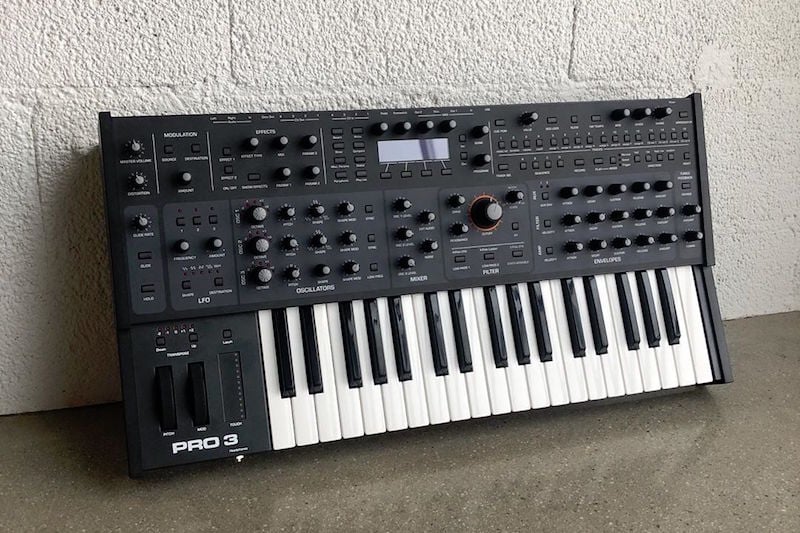
And one of the best things about the Pro-3? Enable paraphonic mode to play three-note chords, or craft interesting counterpoint between analog and digital sounds. Of course, paraphonic means that each "voice" doesn't have its own filter, envelopes, or LFOs, so don't expect the Pro 3 to behave like a true polysynth in this mode. But because each oscillator retains its individual settings in this mode, like waveform and tuning, its possible to easily achieve some clever compositional tricks that might otherwise be reserved for sprawling modular rigs.
Like all Sequential products, we find that the Pro 3 boasts a unique set of features to liven up any studio in a number of ways. If you're already set on your preferred polysynth but still crave some of the Prophet sound in your productions and performances, you'll certainly find that in the Pro 3. And between its gargantuan number of modulation opportunities and powerful, performable sequencer, the Pro 3 can also serve as an impressive command center for coordinating all of your other studio gear with its own heavy-hitting sound. And of course, don't forget the Pro 3 SE, which adds a tilt-able front panel and wood detail, giving this timeless synth an even more timeless look.
As the Prophet Foretold
No doubt, Sequential is one of the first names that comes to mind when discussing polyphonic synthesizers. From the timeless Prophet-5 to the forward-thinking Prophet X, each model of Sequential instrument has an astonishing range of expression avaialble—and with that comes an astonishing level of relevance to an astonishing range of music.
And of course, Sequential offers instruments appropriate to nearly any budget and workflow. From the humble yet quite powerful Take 5 all the way to the top-of-the line Prophet-10, their instruments can find a place in any musician's life. Looking for a deceptively powerful monosynth? The Pro-3 has got your back. Need a stage keyboard with electric piano, string, and uncommonly flexible synth sounds? Check out the Prophet X. Scoring film or television, and need something that cuts straight into our sense of nostalgia? The Prophet-5 is pure warm memories served on a platter. Need a gnarly, unruly polysynth that covers all your touring sound needs, from thick unisons and lush brass to spacy effects? Check out the OB-6. Need loads of polyphony and bi-timbral layers? Check out the Rev2.
Sequential continues to make some of the best synths available on the market—and we're beyond excited to imagine what they might do next.

